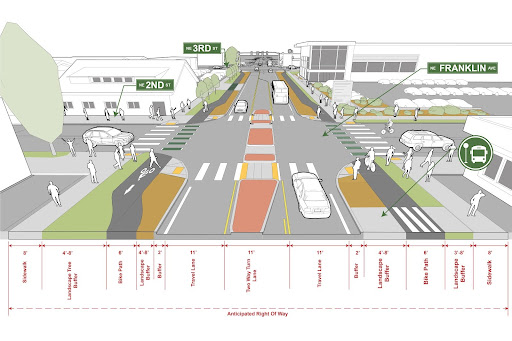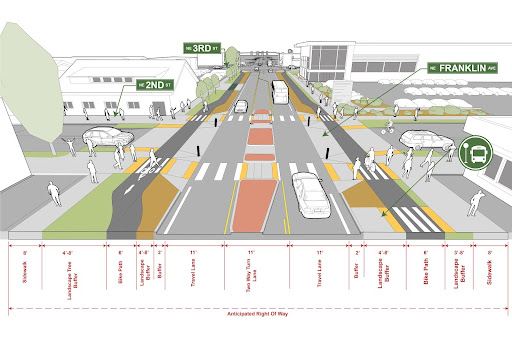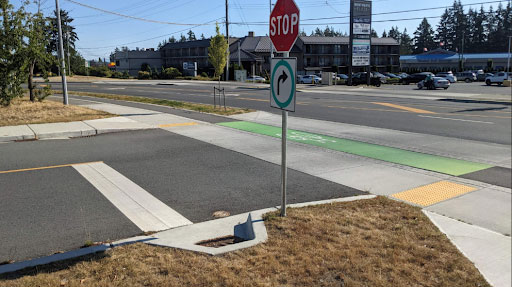The city is starting to build raised bike lanes and multi-use paths outside the curb on many main streets. Examples include: Butler Market Rd, Olney Avenue, Bend Bikeways, and the Franklin Corridor. These bike lanes and paths offer lots of protection to people walking, biking, and rolling since they are separated from traffic by the curb and often by a landscaping strip. But… at the intersections, we’re right back in the traffic.
These raised lanes and paths are a big investment and a wonderful improvement to on-the-street bike lanes. That investment is not fully realized when the raised lanes and paths on main streets are regularly interrupted to cross side streets. Raising them across these side streets would be easy and vastly increase their value as well as the comfort level of the entire path.
People using traditional sidewalks have to move down to street level and back up to sidewalk level at every intersection. The design of the new raised bike lanes and multi-use paths follow this pattern–at every intersection people walking, biking, and rolling must drop to street level, cross the street, and climb back up to sidewalk level on the other side. It is clear from this design that cars have priority and that people outside of cars are crossing traffic lanes even when they are moving along the main street. By raising the sidewalks, multi-use paths, and bike lanes across the intersections—keeping them level across the intersection—we get these benefits:
- People traveling along the main street are given priority over people traveling along the side streets and across the main street.
- Since people walking and biking are raised above street level, they are more visible to drivers entering or leaving the main street and are thus safer.
- Vehicle traffic is slowed when entering the neighborhoods adjacent to main streets because the raised crossings act as speed bumps. Traffic cutting through these neighborhoods is reduced and slowed when entering the neighborhood.
- Drivers on the local street are required to mount the raised intersection, removing their dangerous behavior of consistently blowing through the crosswalk and nosing up to the roadway without yielding to people walking, biking, and rolling.
- The design is congruent with National Association of City Transportation Officials (NACTO) recommendations for safe streets.
Here are two visions of the Franklin Corridor project. The first comes directly from the city’s open house materials. The second shows how the raised crossings would look. A third image shows an example of a raised crossing at a side street.
NE 2nd St and NE Franklin Ave Rendering Without Raised Crossing

View of the Franklin Corridor Project without raised crossings at intersections.
NE 2nd St and NE Franklin Ave Rendering With Raising Crossing

View of the Franklin Corridor Project modified with raised crossings at side streets.
Real World Example of a Raised Crossing

Unless we include raised crossings at local intersections, we risk building raised sidewalks, bike lanes, and multi-use paths which will only be used by adults and people who must use them. They will not be truly comfortable spaces for all people. Let’s make sure we get the full value from these otherwise great investments.
Bend Bikes will be advocating to include raised crossings at local intersections along main streets whenever existing streets are rebuilt and when new streets are constructed. Our current city street standards allow raised crossings only at crossings to the main pedestrian entrance to a school or a park and we will be working to get this standard changed. Raised crossings on local streets are important for improving the safety of people walking, biking, or rolling and for slowing traffic through neighborhoods. Please join us in encouraging the city to use raised crossings to make us all safer!
